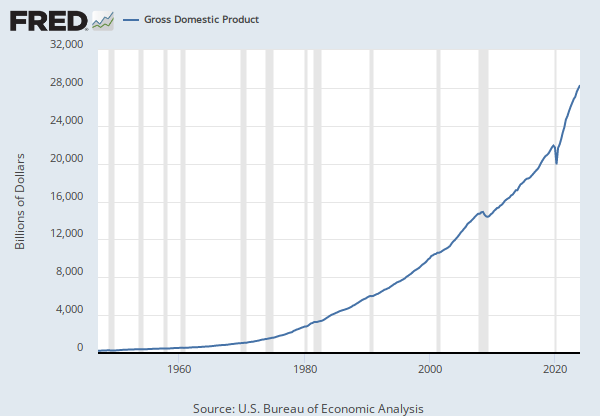FRED Graph
Data in this graph are copyrighted. Please review the copyright information in the series notes before sharing.
Notes
Source: U.S. Bureau of Economic Analysis
Release: Gross Domestic Product
Units: Percent Change from Preceding Period, Seasonally Adjusted Annual Rate
Frequency: Quarterly
Notes:
BEA Account Code: A191RL
Gross domestic product (GDP) is the value of the goods and services produced by the nation's economy less the value of the goods and services used up in production. GDP is also equal to the sum of personal consumption expenditures, gross private domestic investment, net exports of goods and services, and government consumption expenditures and gross investment. Real values are inflation-adjusted estimates—that is, estimates that exclude the effects of price changes.
For more information about this series, please visit the Bureau of Economic Analysis.
Suggested Citation:
U.S. Bureau of Economic Analysis, Real Gross Domestic Product [A191RL1Q225SBEA], retrieved from FRED, Federal Reserve Bank of St. Louis; https://fred.stlouisfed.org/series/A191RL1Q225SBEA, April 30, 2025.
Source: Federal Reserve Bank of Atlanta
Release: GDPNow
Units: Percent Change at Annual Rate, Seasonally Adjusted Annual Rate
Frequency: Quarterly
Notes:
GDPNow is a nowcasting model for gross domestic product (GDP) growth that synthesizes the bridge equation approach relating GDP subcomponents to monthly source data with factor model and Bayesian vector autoregression approaches. The GDPNow model forecasts GDP growth by aggregating 13 subcomponents that make up GDP with the chain-weighting methodology used by the US Bureau of Economic Analysis.
The Federal Reserve Bank of Atlanta's GDPNow release complements the quarterly GDP release from the Bureau of Economic Analysis (BEA). The Atlanta Fed recalculates and updates their GDPNow forecasts (called "nowcasts") throughout the quarter as new data are released, up until the BEA releases its "advance estimate" of GDP for that quarter. The St. Louis Fed constructs a quarterly time series for this dataset, in which both historical and current observations values are combined. In general, the most-current observation is revised multiple times throughout the quarter. The final forecasted value (before the BEA's release of the advance estimate of GDP) is the static, historical value for that quarter.
For futher information visit the Federal Reserve Bank of Atlanta.
Suggested Citation:
Federal Reserve Bank of Atlanta, GDPNow [GDPNOW], retrieved from FRED, Federal Reserve Bank of St. Louis; https://fred.stlouisfed.org/series/GDPNOW, April 30, 2025.
Source: Indiana University: Indiana Business Research Center
Release: Brave-Butters-Kelley Indexes
Units: Annualized Percent Change from Preceding Period, Seasonally Adjusted
Frequency: Monthly
Notes:
The Brave-Butters-Kelley Indexes (BBKI) are the byproduct of research originally conducted by the Federal Reserve Bank of Chicago. Currently, the BBKI are maintained and produced by the Indiana Business Research Center at the Kelley School of Business at Indiana University. The BBK Coincident and Leading Indexes and Monthly GDP Growth for the U.S. are constructed from a collapsed dynamic factor analysis of a panel of 490 monthly measures of real economic activity and quarterly real GDP growth.
The leading subcomponent of the cycle is expressed in annualized real GDP growth equivalent units. The cycle component is the sum of the leading and lagging subcomponents.
For more details, see also:
Brave, Scott A., Ross Cole, and David Kelley, 2019, A 'big data' view of the U.S. economy: Introducing the Brave-Butters-Kelley Indexes, Chicago Fed Letter, Federal Reserve Bank of Chicago, No. 422. Crossref, https://doi.org/10.21033/cfl-2019-422
Brave, Scott A., R. Andrew Butters, and David Kelley, 2019, A new 'big data' index of U.S. economic activity, Economic Perspectives, Federal Reserve Bank of Chicago, Vol. 43, No. 1. Crossref, https://doi.org/10.21033/ep-2019-1
Suggested Citation:
Indiana University. Indiana Business Research Center, Brave-Butters-Kelley Cycle: Leading Subcomponent of GDP [BBKMCLE], retrieved from FRED, Federal Reserve Bank of St. Louis; https://fred.stlouisfed.org/series/BBKMCLE, April 30, 2025.
Release Tables
- Table 1.1.1. Percent Change From Preceding Period in Real Gross Domestic Product: Quarterly
- Table 1.1.2. Contributions to Percent Change in Real Gross Domestic Product: Quarterly
- Table 1.2.1. Percent Change From Preceding Period in Real Gross Domestic Product by Major Type of Product: Quarterly
- Table 1.2.2. Contributions to Percent Change in Real Gross Domestic Product by Major Type of Product: Quarterly
- Table 1.3.1. Percent Change From Preceding Period in Real Gross Value Added by Sector: Quarterly
- Table 1.4.1. Percent Change From Preceding Period in Real Gross Domestic Product, Real Gross Domestic Purchases, and Real Final Sales to Domestic Purchasers: Quarterly
- Table 1.5.1. Percent Change From Preceding Period in Real Gross Domestic Product, Expanded Detail: Quarterly
- Table 1.5.2. Contributions to Percent Change in Real Gross Domestic Product, Expanded Detail: Quarterly
- Table 1.7.1. Percent Change from Preceding Period in Real Gross Domestic Product, Real Gross National Product, and Real Net National Product: Quarterly
- Table 1.8.3. Command-Basis Real Gross Domestic Product and Gross National Product, Quantity Indexes: Quarterly
- Table 1.17.1. Percent Change From Preceding Period in Real Gross Domestic Product, Real Gross Domestic Income, and Other Major NIPA Aggregates: Quarterly
Related Data and Content
Data Suggestions Based On Your Search
Content Suggestions
Other Formats
Real Gross Domestic Product
Billions of Chained 2017 Dollars, Annual, Not Seasonally Adjusted Billions of Chained 2017 Dollars, Quarterly, Not Seasonally Adjusted Billions of Chained 2017 Dollars, Quarterly, Seasonally Adjusted Annual Rate Index 2017=100, Quarterly, Not Seasonally Adjusted Annual, Not Seasonally Adjusted Percent Change from Quarter One Year Ago, Quarterly, Not Seasonally Adjusted Percent Change from Quarter One Year Ago, Quarterly, Seasonally AdjustedBrave-Butters-Kelley Cycle: Leading Subcomponent of GDP
Quarterly, Seasonally AdjustedRelated Categories
Releases
Tags
Permalink/Embed
modal open, choose link customization options
Select automatic updates to the data or a static time frame. All data are subject to revision.































